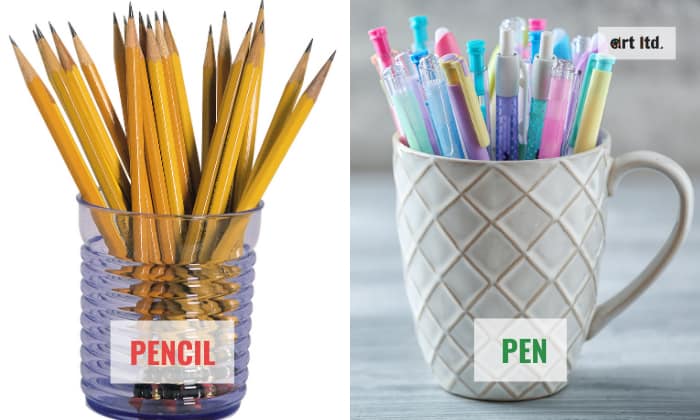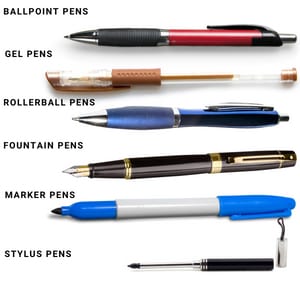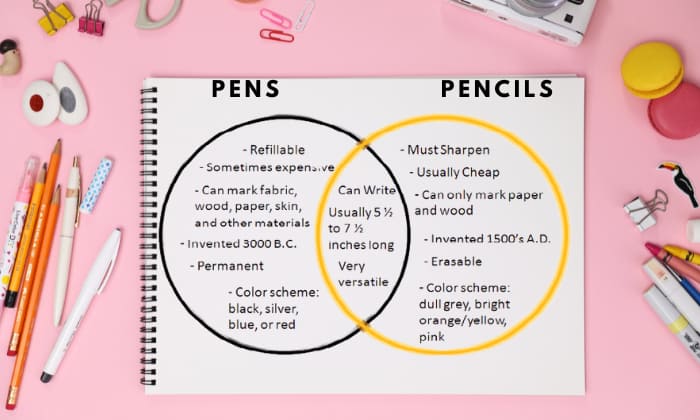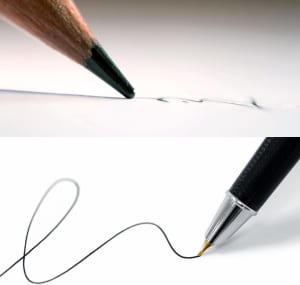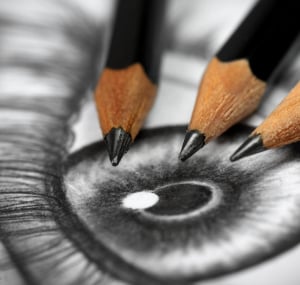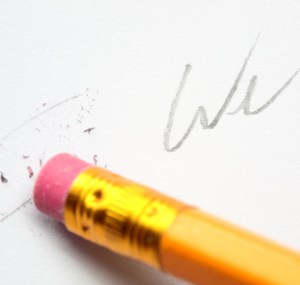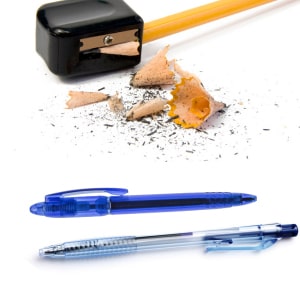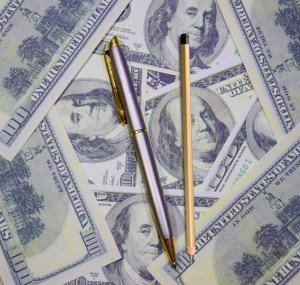We always keep a writing tool at hand, whether it’s for taking notes, sketching, or drawing. Choosing the right tool could make all the difference. In this case, you may be deciding between pencil vs pen.
In this article, we will take a practical look at these two major writing tools, including their history, similarities, differences, and pros/cons. We will also try to see if any of these two is better than the other.
| Features | Pencil | Pen |
| Medium | Graphite, charcoal, carbon, and colored wax | Water- or oil-based ink or gel |
| Casing | Wood, paper, or plastic | Plastic or metal |
| Permanence | Erasable | Permanent |
| Price | Mostly cheap | Can be expensive |
Table of Contents
What is a Pencil?
A pencil is an erasable writing implement that has a slim compacted core made of graphite mixed with clay binders, charcoal, or colored wax.
It’s usually encased with protective materials, typically wood, to prevent color transfer and keep the thin core from crumbling.
The first graphite pencil was invented in the 18th century by Nicholas Jacques Conte, following the discovery of graphite in the 16th century. Following this invention were the addition of erasers, sharpeners, and further innovations, such as mechanical pencils.
Today’s pencils are made with erasers and typically have an iconic hexagonal wood casing. It is categorized or graded according to the proportion of graphite and Kaolin clay used for the core.
Pencil grades
Hard pencils are indicated with H markings and a number. As the number increases, the harder the core is, the less graphite the pencils will leave on the paper, resulting in lighter writing. These are best for detailed and technical drawings.
Soft pencils are indicated with B markings and a number. For this category, the higher the number, the more graphite the pencils will deposit as you write, so the strokes will be darker as well. This type is preferred among artists for sketching and shading.
HB (Hard and black) and F (Fine) types varieties have medium hardness, with the latter option producing darker lines.
Pencil types
- Graphite pencils
- Charcoal and carbon pencils
- Watercolor and colored pencils
- Grease pencils
- Mechanical pencils
- Carpenter’s pencils
- Indelible pencils
- Non-photo blue pencils
- Stenographer’s pencils
- Pop-a-point pencils
- Golf pencils
- Plastic pencils
What is a Pen?
A pen is a modern writing tool that uses various types of ink with a ray of different color options. Its ink is contained in a tube or a cartridge housed in a barrel, which can be either metal or plastic. It also features a tip made with metal, felt, or rubber.
As for ink type, pens usually utilize three main varieties:
- Water-based: this type has low viscosity, resulting in a smoother writing experience with consistent lines. As it features water as the solvent, it dries rather slowly, meaning bleeding or smudging is quite likely.
Writing tools that feature water-based ink include fountain, rollerball, and marker pens.
- Oil-based: featuring oil as solvent, this variety has a thicker consistency but takes much shorter to dry. Oil-based ink can work on almost any surface, making it quite versatile. The only downside to it is the slight resistance feeling the oil creates as you write.
The most common writing tool that features oil-based ink is ball-point and marker pens.
- Gel: while water- and oil-based pens contain dyes dissolved in a solvent, this ink type features powdered pigments mixed (not dissolved) with gel. Therefore, this ink is available in several colors, including glitters. It can dry quickly and doesn’t produce any resistance when writing.
You can find gel ink in gel pens.
Pen types
- Ballpoint pens
- Gel pens
- Rollerball pens
- Fountain pens
- Marker pens
- Stylus pens
Read more: Ballpoint pens vs rollerball pens comparison
Pen vs Pencil: The Similarities?
They are similar in a way that these two are not perfect. Like pens, there are pencil advantages and disadvantages.
In terms of purpose, both can be used to write and produce marks. They also can have about the same length and thickness, although this can vary depending on the type.
These writing instruments are both easy to use and easy to find. They are also very handy, multifunctional, and can be carried anytime, anywhere.
Pen vs Pencil: What Are Their Differences?
1. Writing and colors
One of the disadvantages of a pencil is that writing with a pencil produces fainter lines, whereas writing in pens make more crisp and legible strokes.
Pencil colors are more restricted, as they’re mostly gray or black. Although colored pencils exist, they’re more suitable for drawing rather than writing, and their hue options also aren’t as diverse as pens.
Pens for writing come with a wide variety of ink types that produce hundreds of colors, including special colors like metallic and glitter colors.
2. Drawing
Using a pencil for drawing gives you more room for improvement. These tool illustrators are best for both beginners and experienced artists. Pencils are also better for shading.
Pens are also suitable for drawing, sketching, and shading, but they’re mostly for experienced artists and experts, given how pens usually aren’t erasable.
3. Permanence
Most pens, such as markers and ballpoint pens, are permanent. You can also find archival pens that can resist fading. Pencils, on the other hand, are mostly designed to be erasable.
But there’s a special pen that writes like a pencil. Known as erasable pens, their ink can be removed with friction, heat, or special erasers.
4. Mechanism
Pens have a more complex mechanism than pencils. Regular pencils are generally straightforward to use—you only need to sharpen them from time to time if the tip breaks or becomes blunt.
Meanwhile, pens typically have an ink tube or cartridge and a tip where the ink is released. They may come with a cap and can be retractable, twist-to-open, or click type.
Some pens are disposable, while some are customizable. They may have replaceable tips and refillable ink.
5. Lifespan
The lifespan of pens varies drastically depending on the type. That said, most pens can draw a straight line for 1 to nearly 3 miles. Among them, ballpoint and other oil-based pens last the longest, whereas rollerball pens tend to run out of ink the fastest.
So, how long does a pencil last? A regular pencil can write about 35 miles and can last for around 1 year.
If not in use, a good old pencil can stand the test of time. It does not have an expiry date and can last for 100 years under normal conditions. In contrast, pens’ ink can dry, evaporate, or become clogged with time, so they can only last for about two to four years.
6. Cost
Basic pencils are pretty cheap, with most costing around $0.1 apiece. The price can be even cheaper if you buy pencils in bulk. For example, a 150-piece box will only set you back $14.05, meaning each pencil costs less than $0.1.
Even if you’re to upgrade to a more premium option, such as a high-grade mechanical pencil, the price is still affordable—these would cost around $6 to $24.
On the other hand, pens have a much wider price range. Common options, such as ballpoint pens or rollerball pens, rarely cost over $1 per piece. However, if you’re looking at a premium option like fountain pens, the average range should be $100-$200.
Pros and Cons
Pencil
- Can last longer
- Cheaper
- Can be corrected
- Sustainable
- Less permanent
- The core can break
- Needs frequent sharpening
Pen
- Customizable
- Permanent ink
- More visible and legible
- Can write on different surfaces (for oil-based ink)
- Can be pricey
- Can get dry or clogged
Which is Better?
This argument totally depends on you as a user. It could be connected to the purpose and even to one’s personality. For example, if you’re the type that likes drawing on your hand with a pen, you can’t use a pencil for that.
Generally, pencils are better for writing drafts or for technical drawings where you need an erasable tool. They are considered more sustainable since they use renewable raw materials, unlike pens that are usually made with disposable plastics that are harmful to the environment.
Pens, on the other hand, are better used for notes as professionals or signing documents, where you need the writings to be legible and permanent.
Frequently Asked Questions
What are the ways to use a pencil other than writing?
Other than good handwriting pencils, there are other varieties that can serve the following purposes.
Graphite and mechanical pencils: technical drawing and sketching
Carbon and charcoal pencils: sketching, portraits, and shading
Watercolor and colored pencils: lettering, blending, adding details, and coloring
Are there ink pens that look like pencils?
Yes, some companies, such as Quality Logo Products, make customizable pens with pencil-like designs and use these as promotional items.
What is the psychology behind some pen and pencil practices and habits?
Some habits are believed to be linked to your personality and self-regulation. Common examples are:
Study shows that left-handed are often inclined toward art and sports.
Chewing on pen or pencil tips is interpreted by experts as a way for some people to relieve stress and anxiety.
Conclusion
We hope that this information on pencil vs pen helped you realize the importance of each writing tool. Neither of them is superior to the other; it all depends on the task at hand and on your personal preference.
Both are essential and have their purpose. If you want your writing to be permanent, you would want to have a pen. However, if you want to make something that is bound to be erased and corrected, all you need is a pencil.

Art has always been a part of my life; it influences my upbringing and later my career choice. For me, it is always a part of my parenting technique. So for whichever purpose that you come to art, you can start here with us.
